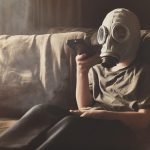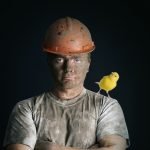Carbon monoxide is a common yet potentially deadly form of gas when we breathe in too much of it as it displaces the oxygen in our organs. Our red blood cells actually pick it up more readily than oxygen. Every now and then we hear of a tragic news report about needless deaths due to carbon monoxide poisoning, such as MTV reality television actor Shain Gandee and his companions.1 Colin Bertram. “MTV “Buckwild” Star Shain Gandee Found Dead,” NBCDFW. Apr 2, 2013. (Accessed 27 Aug 2013.) http://www.nbcdfw.com/entertainment/entertainment-news/NATL-Star-of-Buckwild-Found-Dead-200908881.html But once the news fades from the headlines, most of us don’t give carbon monoxide a thought. According to new research, however, we should all be much more aware of the potential dangers of carbon monoxide poisoning, especially right in our own homes.
The study, which was performed at Virginia Mason Medical Center in Seattle, Washington, found that external sources of carbon monoxide can seep right through the drywall used in most houses and apartment buildings, quickly reaching people within their homes.2 “Carbon Monoxide Penetrates Gypsum Wallboard.” Science Daily. 21 August 2013. Accessed 26 August 2013. http://www.sciencedaily.com/releases/2013/08/130821124254.htm After extensive testing with carbon monoxide being produced only outside the experiment area, the researchers measured elevated levels of carbon monoxide that had penetrated the drywall between apartments or that of an attached garage. Therefore, if a generator is being used to provide electricity after a power outage, for example–even if it was in a neighboring apartment or in the garage–the carbon monoxide would be permeating the air breathed in by the residents inside the home.
The previous theory was that people were safe within the confines of their home as long as there was no internal source of carbon monoxide present. The researchers began considering the possibility that carbon monoxide was making its way through drywall after learning of poisonings that had occurred in various subunits within multifamily structures. There was not always a clear route for the gas through a duct or natural opening, which logically meant that it had to be seeping in from somewhere else.
External sources, such as an adjacent apartment or an attached garage, were not suspected of transmitting the gas unless it was coming through an open door or vents. However, this study showed definitively how the carbon monoxide particles easily pass through the porous gypsum material from which drywall for both walls and ceilings is made. Once the surfaces were painted, the carbon monoxide did not penetrate as quickly as it did unpainted drywall, but it did nevertheless come through. Therefore, the risk may be slightly greater during any kind of construction, but it always appears to exist.
Carbon monoxide is particularly dangerous since it is both odorless and tasteless. We literally have no idea that we are inhaling the gas, but as it actually displaces the oxygen required by our vital organs, we begin to experience such symptoms as headaches, dizziness, nausea, chest pain, and confusion.3 “Carbon Monoxide Poisoning.” Centers for Disease Control and Prevention. 23 July 2013. Accessed 27 August 2013. http://www.cdc.gov/co/faqs.htm Eventually, we lose consciousness and can die. Plus, carbon monoxide is particularly dangerous to babies as well as those with heart conditions, pulmonary issues, or anemia, as they can succumb to its effects faster than others.
These findings certainly highlight the need for serious safety measures we should all consider taking no matter what type of dwelling we inhabit. For those with an attached garage, take care to turn the car engine off even if you are running back into the house for just a few minutes as distractions can always happen. If you use a generator for any reason, always keep it outdoors. Chimneys and flues should be maintained regularly, and gas ovens or stoves should not be used for long stretches of time, especially if they are not power vented.4 Porter, Dana O. “Carbon Monoxide in Homes and Workshops.” West Virginia University Extension Service. Accessed 27 August 2013. http://www.wvu.edu/~agexten/ageng/resource/carbmon.htm
It’s also a good idea for every home to have at least one carbon monoxide detector to ensure that the gas is not entering from some other location. That especially holds true for those living in an apartment, since you really have no idea what your neighbors in any direction might be doing. Remain vigilant about carbon monoxide exposure because it can add up quickly to toxic levels in the body and a full body detox may not rid the body of it. The red blood cells try to retain it to such a degree that doctors must use pure oxygen to flush the molecules from the circulatory system, a form of blood cleansing. And if exposure takes place while you are sleeping, there likely won’t even be any symptoms to alert you to a possible problem.
References
| ↑1 | Colin Bertram. “MTV “Buckwild” Star Shain Gandee Found Dead,” NBCDFW. Apr 2, 2013. (Accessed 27 Aug 2013.) http://www.nbcdfw.com/entertainment/entertainment-news/NATL-Star-of-Buckwild-Found-Dead-200908881.html |
|---|---|
| ↑2 | “Carbon Monoxide Penetrates Gypsum Wallboard.” Science Daily. 21 August 2013. Accessed 26 August 2013. http://www.sciencedaily.com/releases/2013/08/130821124254.htm |
| ↑3 | “Carbon Monoxide Poisoning.” Centers for Disease Control and Prevention. 23 July 2013. Accessed 27 August 2013. http://www.cdc.gov/co/faqs.htm |
| ↑4 | Porter, Dana O. “Carbon Monoxide in Homes and Workshops.” West Virginia University Extension Service. Accessed 27 August 2013. http://www.wvu.edu/~agexten/ageng/resource/carbmon.htm |










